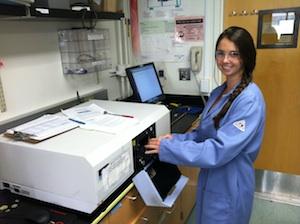
That college student working bleary eyed at her laptop at 3 am, that football fan capturing a brilliant touchdown with his cellphone—both are relying on new white lighting technology based on light emitting diodes (LEDs).
Light bulbs, flashlights, and car headlights are all a lot brighter than they used to be. That’s because of advances in solid-state white lighting. LEDs are now used in devices that have longer lifetimes and consume less energy than traditional lighting. The technology is also important for the environment because LEDs don’t use mercury, as do older lighting devices.
LEDs are made using phosphors that convert the blue or ultraviolet light emitted from the LED into the longer wavelengths of blue, green, yellow, or red. These colors of the visible spectrum then mix to create white light.
The key term in LED development is white light quality. The phosphor material that is used greatly affects the overall device, including the luminous efficacy, color rendition, thermal and chemical stability, and the color quality of the light.
Specific luminescence properties are needed to produce an optimal white light with a high color-rendering index (Ra). These properties include strong absorption in the region of the LED emission and a broad emission profile across all regions of the visible spectrum.
The thermal stability of the phosphor is also important because thermal quenching of phosphor luminescence leads to decreased efficiency and color instability at the operating temperatures of modern devices. In addition, the phosphors must be highly efficient if they are to convert the LED emission with little or no energy loss.
The most commonly used phosphor for solid-state white lighting is yellow-emitting cerium-doped yttrium aluminum garnet (YAG). Although efficient, the quality of the white light YAG produces is not perfect. Emission in the red region of the visible spectrum is inadequate, and temperature stability is poor.
Recently, however, neutron scattering research at Oak Ridge National Laboratory’s Spallation Neutron Source (SNS) was used to develop new phosphor compositions. Materials chemistry researchers from the University of California at Santa Barbara teamed with NOMAD instrument scientist Jörg Neuefeind to study a new phosphor material that they had developed. NOMAD is a nanoscale-ordered materials diffractometer that effectively uses the high neutron flux at SNS that is essential for this research.
The new phosphor composition, Sr2Ba(AlO4F)1-x(SiO5)x:Ce3 , has high thermal stability and high quantum efficiency, and its green-to-yellow emission color is easily tunable. The new phosphor has a broad emission spectrum that covers a wide range of colors in the visible spectrum, including some red. This makes for devices that render better color and a warmer white light.
“In our research, we are working to understand the composition and structure of materials with their properties, and then we use this knowledge to engineer better materials,” said Kristin Denault, a PhD student and the leader of the University of California research team. “A phosphor comprises a host crystal structure with small substitutions of activator ions, such as Ce3 . The local environment around the activator ion dictates the optical properties of the phosphor. With the help of NOMAD, we set out to elucidate the local atomic structure of Ce3 in this new family of phosphors.”The experiment required the researchers to obtain high momentum-transfer neutron scattering data to analyze the distance between pairs of specific atoms in the material (called the pair distribution function). This information enables them to reconstruct the phosphor’s local atomic structure. NOMAD is particularly suited for this work because of its enhanced neutron flux and its advanced neutron optics and detector features. These capabilities allow for unprecedented access to the local atomic structure at high resolution.
The researchers combined density functional theory, synchrotron x-ray scattering data from the Advanced Photon Source at Argonne National Laboratory, and electron paramagnetic resonance with the NOMAD data to reveal details of the phosphor structure. The combined techniques were key to the success of the experiment.
“Through examining the structure of a new phosphor composition with excellent properties for solid-state white lighting, we have gained knowledge as to the structure, composition, and property relationships that exist,” Denault said. “We plan to use this knowledge to develop new and improved phosphor compositions. An example would be to develop red-emitting phosphors that show good thermal stability, a property that is uncommon among this family of phosphors.”
“More generally,” said Denault, “the research points to how chemical substitutions play a crucial role in tuning the optical and thermal properties of the material.”
The research at SNS was funded by the US Department of Energy Office of Basic Energy Sciences.
Research Contact: Kristin Denault
Published Work
Kristin A. Denault, Nathan C. George, Sara R. Paden, Stuart Brinkley, Alexander A. Mikhailovsky, Jörg Neuefeind, Steven P. DenBaars, and Ram Seshadri, “A green-yellow emitting oxyfluoride solid solution phosphor Sr2Ba(AlO4F)1-x(SiO5)x:Ce3 for thermally stable, high color rendition solid state white lighting”,J. Mater. Chem. 22, 18204-18213 (2012); DOI: 10.1039/c2jm33620k.

